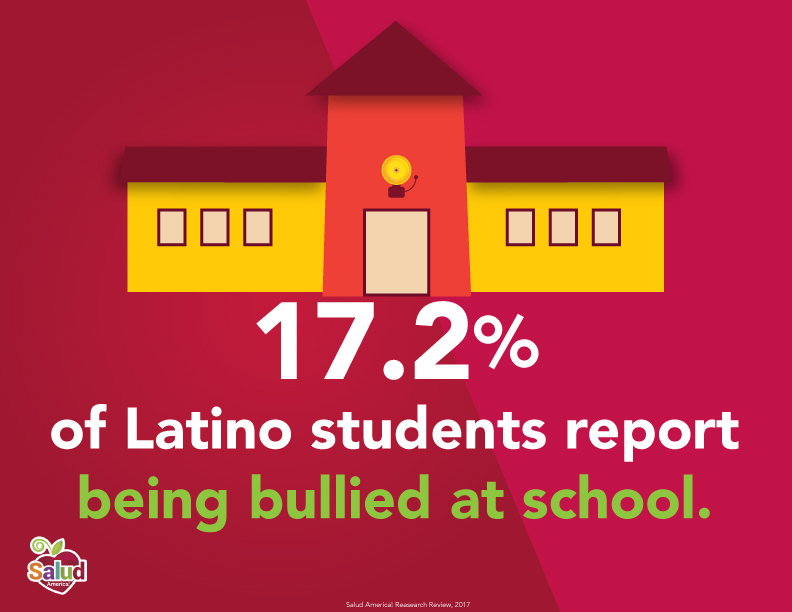
Share On Social!
This is part of our Mental Health & Latino Kids: A Research Review »
Community stressors are linked to Latino kids’ depression, etc.
Garcia and Lindgren recruited 53 Latino adolescents and caretakers to participate in focus groups in which participants would discuss mental health stressors. There were two focus groups each for boys, girls, mothers, and fathers.
The boys’ groups generally focused their discussions on racism and discrimination, particularly racial profiling. One of the boys’ groups consisted of adolescents recruited from a community center with a program for truants. They discussed stressors that were not identified in the non-truant group, including gang activity, violence, and substance use disorder.
In the girls’ groups, discrimination and immigration were identified as stressors, as were issues related to family, school, and peers.
In the parent groups, both mothers and fathers focused on their parental responsibilities and how they affect their families; interestingly, the mothers discussed how both their sons and daughters were affected by stress, while the fathers tended to discuss stress as it related to themselves and to their sons.23
Community stressor: Discrimination
A cross-sectional review of data from the Children of Immigrants Longitudinal Study (CILS) by Lopez at al. found that depressive symptoms in U.S.-born Latino high school students was significantly associated with discrimination from teachers (p<.05) and students (p<.05).
The authors also found a significant association between depressive symptoms and discrimination from other Latinos, so-called co-ethnic discrimination.24
In the cross-sectional study by Umaña-Taylor and Updegraff16 involving Latino adolescents, the exploration and resolution of ethnic identity positively predicted self-esteem, which in turn exhibited a partially mediating effect on the relationship between perceived discrimination and depression.
For boys and girls, perceived discrimination was associated with symptoms of depression when controlling for self-esteem.
Overall, sex and perceived discrimination were significant predictors of depressive symptoms, with girls reporting higher levels of depressive symptoms.
In interviews conducted with Latino immigrant mothers and their adolescent children, Stacciarini et al. also examined community and social factors affecting the mental health of Latino children.
Adolescents (those raised in the U.S. and those who emigrated) reported feeling like outsiders in their schools, and reported having experienced overt racism and discrimination.
Many of the adolescents stated that the only place in their community where they felt truly safe and welcomed was church.
Undocumented status was cited by both adolescents and mothers as a constant source of fear and anxiety; mothers worried that their children’s well-being would be negatively affected by their undocumented status.
For adolescents, other stressors included not being able to participate in extracurricular activities due to a lack of transportation, lack of friends, family conflict, and language difficulties.25
Community stressor: Violence
Andrews et al. conducted a cross sectional study of data from the National Survey of Adolescents-Replication (NSA-R) 2005, a computer-assisted telephone interview of 3,614 youth ages 12-17, 409 of whom identified as Latino, to determine whether there were any differences in trauma-related mental health problems based on ethnicity.
The authors were also interested in whether polyvictimization (having experienced multiple types or incidences of trauma, including physical and sexual assault and/or abuse and witnessed violence) and household income had any mediating effects on participants’ mental health.
Latino youth reported significantly greater symptoms of depression and post-traumatic stress disorder (PTSD) than their white peers (p<.001), even after controlling for polyvictimization (p=.39).
Low-income youth in general had a greater relationship between mental health symptoms and polyvictimization.26
School stressor: Teacher stress
School is an important factor in children’s mental health and development as well.
In an issue brief regarding teacher stress, Greenberg et al. observed that 46 percent of teachers reported high daily stress, which has several negative consequences, including poor teacher performance and poor student outcomes.
High levels of stress among teachers is also linked to a high turnover rate, which disproportionately impacts schools in low-income neighborhoods, leading to destabilization of these schools.
The disruptions to parent-teacher, student-teacher, and teacher-community relationships results in increased education iniquity.27
School stressor: Bullying
Bullying also can affect physical and emotional health and increase risk of mental health problems, headaches, problems adjusting to school or academic problems, depression, substance use, and long-term damage to self-esteem.28–30
 About 24.7% of African-American students, 17.2% of Hispanic students, and 9% of Asian students report being bullied at school, according to the National Center for Educational Statistics.31
About 24.7% of African-American students, 17.2% of Hispanic students, and 9% of Asian students report being bullied at school, according to the National Center for Educational Statistics.31
Race-related bullying is significantly associated with negative emotional and physical health effects.32
In a study of more than 7,000 predominantly black and Latino middle- and high-school students, Peskin and colleagues found that victims of bullying reported frequent worries, sadness, nervousness, and fearfulness.33
Latino parents also listed bullying as their No. 1 children’s health concern, and they reported more concern than white parents about their children’s stress (57% to 42%), depression (53% to 36%), and drug abuse (61% to 47%), according to a 2016 University of Michigan Health System poll.34
Relatedly, school-based bullying prevention programs can decrease bullying by up to 25%, according to a Congressional Research Service report.35
Community stressor: Poverty
The proportion of black (36%) and Latino (31%) children and adolescents living in poverty was more than double that of non-Latino whites (12%) and Asians (13%) in 2016.36
 In a 2008 report, Hanks discussed the effects that living in an impoverished neighborhood had on Latino children. The author volunteered as a home visitor, nurse practitioner, and nursery parent-group leader in a mixed-race (54% Latino) neighborhood in the Southwest from 1997-2004 and conducted focus groups during that time.
In a 2008 report, Hanks discussed the effects that living in an impoverished neighborhood had on Latino children. The author volunteered as a home visitor, nurse practitioner, and nursery parent-group leader in a mixed-race (54% Latino) neighborhood in the Southwest from 1997-2004 and conducted focus groups during that time.
Both adults and children reported witnessing or being the target of discrimination and harassment. Focus group participants reported frequent episodes of police harassment and being ignored by political representatives and police and transportation officials when requesting help.
Parents also felt that school staff were not concerned about their children and lacked warmth.37
In a cross-sectional analysis of data from the Colorado Project on Economic Strain (CoPES), Wadsworth et al. identified a sample of 164 children ages 6-18 and their primary caregivers, 38.3 percent of whom identified as Latino. Participants in the initial CoPES study were recruited from health clinics and Head Start centers in and around Denver, Colo.
To be included in the study, participant families had to have an annual income below 150 percent of the poverty line, a high debt-to-asset ratio, or to have been receiving public assistance. Questionnaire packets were mailed to families to be completed prior to a lab or home visit. The questionnaire was designed to measure family socioeconomic status (SES), poverty-related stress, symptoms of a psychological disorder, physical health, deviancy, and academic performance.
Latino participants were found to experience more detrimental effects due to poverty-related stress than were African Americans, and they also reported more doctor and emergency room visits in the month prior than did whites.38
Lara-Cinisomo, et al., used data from the Project on Human Development in Chicago Neighborhoods (PHDCN) to investigate the effects of neighborhood characteristics and immigrant status on the mental health of Latino youth. Data on 1,040 Latino immigrant youth ages 9-17 were collected in two waves, from 1994-1995 and from 1997-1999.
These youths were identified as first-, second-, or third-generation immigrants and lived in Chicago neighborhoods with similar immigrant concentrations, concentrated disadvantage, and residential stability. The CBCL was used to assess internalizing behaviors.
At Wave 1, internalizing behavior scores were higher in first- and second-generation Latino youth compared to third-generation youth, and first-generation youth had higher levels of internalizing behaviors than the other generations due to language barrier issues and the pressures of acculturation. For this generation, significantly fewer internalizing behaviors were seen in those living in stable neighborhoods (p<.05).
Second-generation youth living in neighborhoods with residential stability had fewer internalizing behaviors, though this was not seen in first- or third-generation youth living in similar neighborhoods.39
The complex interaction of family and community stressors
Interactions may also be seen between neighborhood and economic factors, parenting, and children’s mental health.
In a 2011 study, Gonzales, et al., analyzed data from 750 Mexican-American mothers and 467 Mexican-American fathers with children in the fifth grade who participated in a longitudinal study of Mexican-American families in the Southwest.
Most of the parents were born in Mexico, while most of the children were born in the U.S.
Both mothers and fathers reported perceived economic hardship and perceived neighborhood danger. Parenting behavior was reported using the Children’s Report of Parental Behavior Inventory, and both mothers and children used the Diagnostic Interview Schedule for Children to report internalizing and externalizing symptoms.
A negative association was seen between maternal warmth and externalizing symptoms, while maternal harsh parenting and externalizing symptoms were positively related.
When mothers perceived their neighborhoods to be high in danger, a positive relationship was seen between neighborhood disadvantage and maternal warmth (p<.01), though there was no relationship when neighborhoods were perceived to be average or low in danger.
A negative association was seen between father-reported economic hardship and paternal warmth, and economic hardship was marginally positively related to paternal harsh parenting; paternal harsh parenting was positively related to externalizing symptoms. Both maternal warmth (p<.05) and maternal harsh parenting (p<.05) mediated a significant positive effect of economic hardship on externalizing symptoms.40
White et al. examined data from the same study and created an integrated model to investigate the effects of neighborhood, family, and culture on the mental health of Mexican-American youth. Study measures included perceived neighborhood risk, objective neighborhood risk, cultural values, parent and family functioning, and youth mental health.
There was no evidence of the mediating effects of neighborhood risk on youth mental health outcomes—the authors’ first hypothesis.
A second hypothesis, the contextual relevance model, suggests that the effectiveness of parenting and family functioning on youth mental health is qualified by actual, or objective, neighborhood risk rather than perceived risk.
Significant effects were seen under this model; using mother-reported information, objective risk moderated the effect of maternal warmth on externalizing symptoms (p<.05).
There was no association between parental warmth and externalizing symptoms among those living in high risk neighborhoods, but among those living in good neighborhoods, there was a significant association between parental warmth and decreased externalizing symptoms (p<.001).
Living in a high-risk neighborhood was also associated with decreased externalizing (p<.01) and internalizing (p<.001) symptoms associated with family cohesion. A similar association between, family cohesion, internalizing symptoms, and living in a high-risk neighborhood was seen in the youth report model (p<.001).41
A study of 90 low-income Latino middle schoolers and their primary caregivers examined the relationship between poverty-related stress (characterized by exposure to violence, economic stress, discrimination, and deteriorating family relationships), family coping, immigrant status, familism, and family ethnic socialization on the mental health of Latino adolescents.
Approximately half of the study participants identified as first-generation Latinos, and 32 percent identified as immigrants; all were on a free or reduced school lunch program.
Child reporting of internalizing (p=.03) and externalizing (p=.04) symptoms were associated with income to poverty ratio; these symptoms became somewhat limited when moderated by high levels of familism.42
More from our Mental Health & Latino Kids: A Research Review »
- Introduction & Methods
- Key Research Finding: Issues facing Latino kids
- Key Research Finding: Latino kids access to care
- Key Research Finding: The migration experience
- Key Research Finding: Latino family issues
- Key Research Finding: Latino community and school issues (this section)
- Key Research Finding: Programs with promise
- Key Research Finding: Policies with promise
- Policy Implications
- Future Research Needs
References for this section »
23. Garcia, C. & Lindgren, S. “Life Grows Between the Rocks” Latino adolescents’ and parents’ perspectives on mental health stressors. Res. Nurs. Health 32, 148–162 (2009).
24. Lopez, W. D., LeBrón, A. M. W., Graham, L. F. & Grogan-Kaylor, A. Discrimination and Depressive Symptoms Among Latina/o Adolescents of Immigrant Parents. Int. Q. Community Health. Educ. 36, 131–140 (2016).
25. Stacciarini, J.-M. R., Smith, R., Garvan, C. W., Wiens, B. & Cottler, L. B. Rural Latinos’ Mental Wellbeing: A Mixed-methods Pilot study of Family, Environment and Social Isolation Factors. Community Ment. Health J. 51, 404–413 (2015).
26. Andrews, A. R. et al. Polyvictimization, income, and ethnic differences in trauma-related mental health during adolescence. Soc. Psychiatry Psychiatr. Epidemiol. 50, 1223–1234 (2015).
27. Greenberg, M. T., Brown, J. & Abenavoli, R. Teacher stress issue brief: effects on teachers, students, and schools. (PennState & Robert Wood Johnson Foundation, 2016).
28. The Centers for Disease Control and Prevention (CDC). Understanding Bullying Fact Sheet. (2016). Available at: http://www.cdc.gov/violenceprevention/pdf/bullying_factsheet.pdf. (Accessed: 17th June 2016)
29. Smokowski PR & Kopasz KH. Bullying in school: an overview of types, effects, family characteristics, and intervention strategies. Child. Sch. 27, 101–110 (2005).
30. Korioth, T. Signs of Bullying: Important Questions for Parents to Ask. HealthyChildren.org (2016). Available at: http://www.healthychildren.org/English/safety-prevention/at-play/Pages/Bullies-Beat-Down-Self-Esteem.aspx. (Accessed: 18th August 2017)
31. Lessne, D. & Yanez, C. Student Reports of Bullying: Results from the 2015 School Crime Supplement to the National Crime Victimization Survey. Web Tables. NCES 2017-015. Natl. Cent. Educ. Stat. (2016).
32. Rosenthal, L. et al. Weight- and race-based bullying: Health associations among urban adolescents. J. Health Psychol. 20, 401–412 (2015).
33. Peskin, M. F., Tortolero, S. R., Markham, C. M., Addy, R. C. & Baumler, E. R. Bullying and Victimization and Internalizing Symptoms among Low-Income Black and Hispanic Students. J. Adolesc. Health 40, 372–375 (2007).
34. C.S. Mott Children’s Hospital. National Poll on Children’s Health: Mental health, racial inequities lead 2016 Top 10 child health concerns. (2016). Available at: http://mottnpch.org/reports-surveys/mental-health-racial-inequities-lead-2016-top-10-child-health-concerns. (Accessed: 18th August 2017)
35. McCallion, G. & Feder, J. Student Bullying: Overview of Research, Federal Initiatives, and Legal Issues. (2013).
36. Kids Count Data Center, The Annie E. Casey Foundation. Children in poverty by race and ethnicity. (2017). Available at: http://datacenter.kidscount.org/data/Tables/44-children-in-poverty-by-race-and-ethnicity. (Accessed: 18th August 2017)
37. Hanks, C. A. Social Capital in an Impoverished Minority Neighborhood: Emergence and Effects on Children’s Mental Health. J. Child Adolesc. Psychiatr. Nurs. 21, 126–136 (2008).
38. Wadsworth, M. E. et al. An Indirect Effects Model of the Association Between Poverty and Child Functioning: The Role of Children’s Poverty-Related Stress. J. Loss Trauma 13, 156–185 (2008).
39. Lara-Cinisomo, S., Xue, Y. & Brooks-Gunn, J. Latino youth’s internalising behaviours: links to immigrant status and neighbourhood characteristics. Ethn. Health 18, 315–335 (2013).
40. Gonzales, N. A. et al. Economic Hardship, Neighborhood Context, and Parenting: Prospective Effects on Mexican–American Adolescent’s Mental Health. Am. J. Community Psychol. 47, 98–113 (2011).
41. White, R. M. B., Roosa, M. W. & Zeiders, K. H. Neighborhood and Family Intersections: Prospective Implications for Mexican American Adolescents’ Mental Health. J. Fam. Psychol. JFP J. Div. Fam. Psychol. Am. Psychol. Assoc. Div. 43 26, 793–804 (2012).
42. Santiago, C. D. & Wadsworth, M. E. Family and Cultural influences on Low-income Latino Children’s Adjustment. J. Clin. Child Adolesc. Psychol. Off. J. Soc. Clin. Child Adolesc. Psychol. Am. Psychol. Assoc. Div. 53 40, 332–337 (2011).
Explore More:
Healthy Families & SchoolsBy The Numbers
142
Percent
Expected rise in Latino cancer cases in coming years



